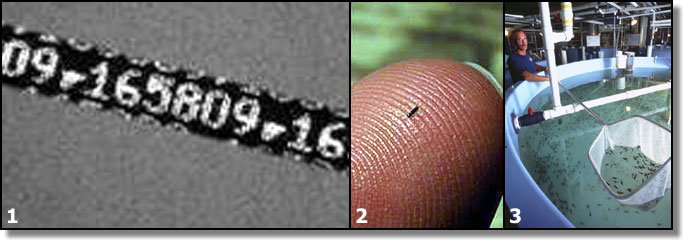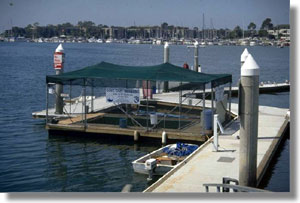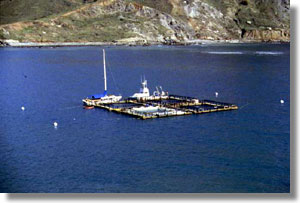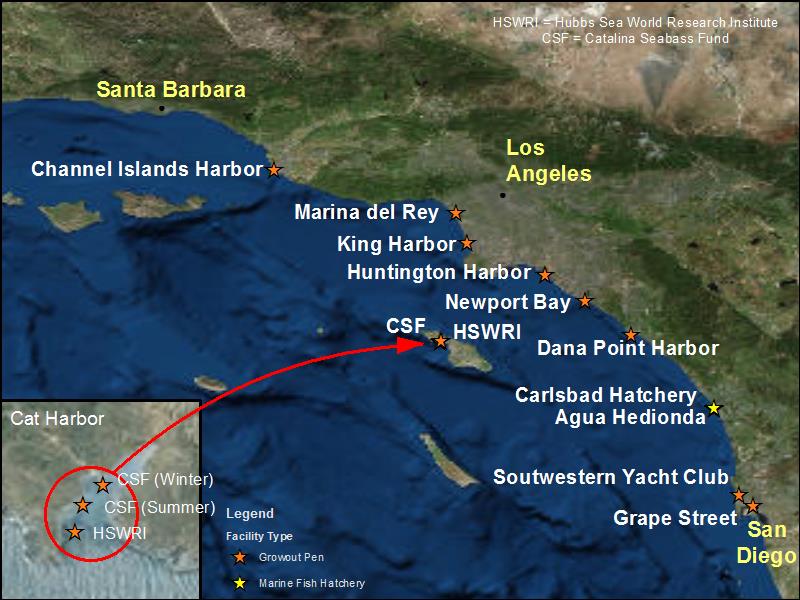Overview
In 1995, the Ocean Resources Enhancement and Hatchery Program (OREHP) completed construction of the Leon Raymond Hubbard, Jr. Marine Fish Hatchery in Carlsbad, California. The hatchery is designed to produce more than 350,000 juvenile white seabass annually. It has seven separate systems: larval food production, broodstock, egg incubation, juvenile 1, juvenile 2, raceway culture, and experimental.
For more information, visit the Hubbs-Sea World Research Institute website(opens in new tab)
Broodstock
Five broodstock tanks hold fish collected from the wild under controlled environmental conditions to induce spawning. The water temperature and photoperiod are manipulated to simulate springtime conditions, which stimulates the broodstock to reproduce. Females release as many as 1.5 million eggs each time they spawn, and they are capable of several spawns during a season. Before being introduced into the existing adult population, the sex of each new brood fish is determined, a tissue sample is taken for genetic analysis, a health examination is performed, and an identification tag is inserted in the dorsal musculature.
Larval Rearing and Post-Larval Culture
The larval rearing area houses fish up to 2 inches long that were hatched from the fertilized eggs collected from the broodstock tanks during spawning events. At about 12 days post-hatch, the fish are moved into the Juvenile 1 system, where they are weaned off of live Artemia feed onto a dry pelleted feed. Once the fish are completely weaned, they are transferred into the Juvenile 2 system where they remain until they are large enough (4 inches long) to be transported to one of the grow-out facilities. Each fish is tagged with a small, coded-wire tag (1 millimeter long) in the cheek muscle prior to transfer to the grow-out facilities.
 From left: Magnified coded wire tag (photo courtesy of Northwest Marine Technologies, Inc.); Coded wire tag on fingertip to show scale (photo courtesy of Northwest Marine Technolgies, Inc.); Juvenile tank at the hatchery in Carlsbad (photo courtesy of HSWRI)
From left: Magnified coded wire tag (photo courtesy of Northwest Marine Technologies, Inc.); Coded wire tag on fingertip to show scale (photo courtesy of Northwest Marine Technolgies, Inc.); Juvenile tank at the hatchery in Carlsbad (photo courtesy of HSWRI)
Growout Facilities
Thirteen grow-out facilities (net pens, floating raceways, or land-based pools) are currently in operation from San Diego to Santa Barbara, including two pens at Catalina Island. These facilities are designed, constructed, and operated by volunteers associated with angler groups and non-profit organizations. Fish are transferred to these facilities at about 3 to 4 months of age and remain there until they are large enough and are cleared by the CDFW fish pathologist for release.
 White seabass growout pens in San Diego Bay. Photo courtesy of HSWRI.
White seabass growout pens in San Diego Bay. Photo courtesy of HSWRI.
 White seabass growout pens near Catalina Island. Photo courtesy of HSWRI.
White seabass growout pens near Catalina Island. Photo courtesy of HSWRI.
 OREHP Growout Facility Locations.
OREHP Growout Facility Locations.
Releasing White Seabass
Most white seabass are released directly from the grow-out facility; however, some are transported to remote locations for release (such as Mission Bay and Oceanside) to more evenly distribute the fish along the coast. At the time of release, all fish are counted checked for tag retention, and a sub-sample are measured and weighed. The fish are released as a group, usually in the afternoon on an outgoing tide. To optimize survival, white seabass are released during the summer months, at 6 to 9 months of age and 8 to 10 inches in length.